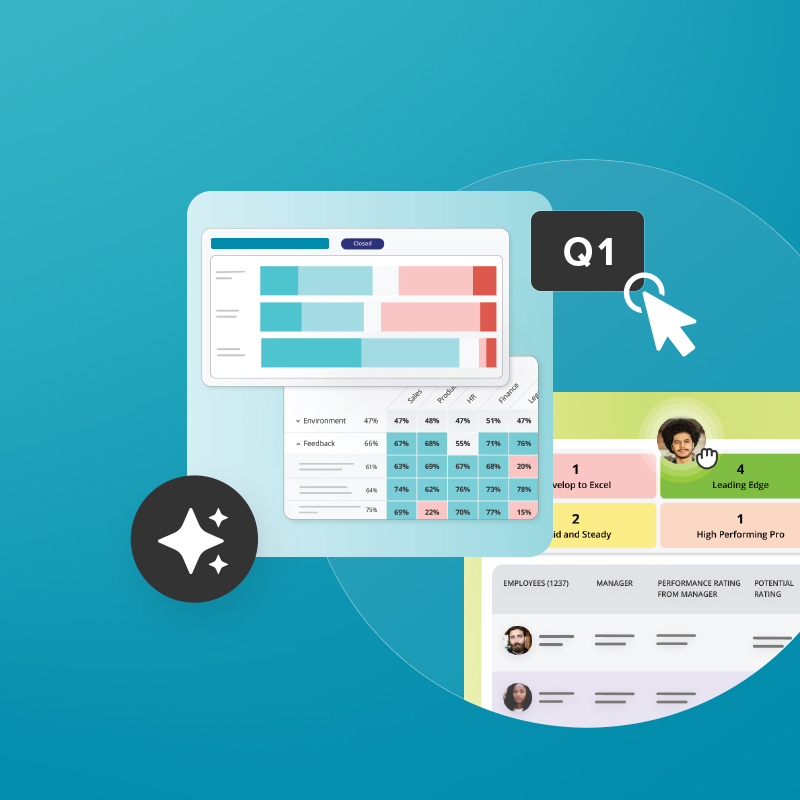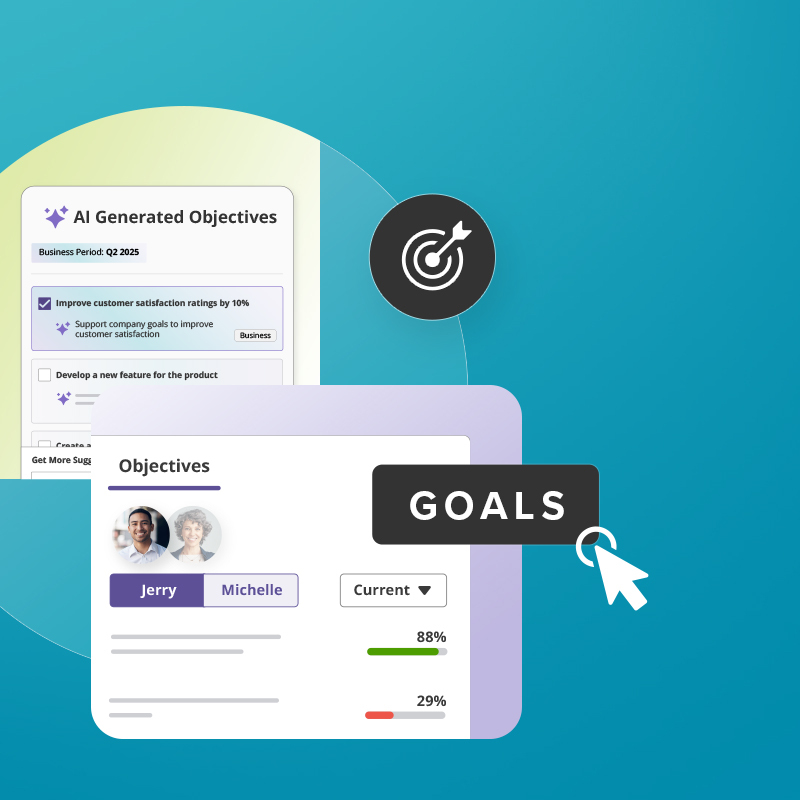- #1: Monetary rewards may cause the wrong outcomes
- #2: Performance-based pay magnifies bias and inequity
- #3: Compensation as a black box is losing favor
- #4: Remote and hybrid work challenges the concept of fairness
- #5: The annual review is the only review
- It’s time to reimagine a system that rewards employees fairly
- Separating compensation from performance improves performance
- Mixing performance enablement and modern calibration
- Case in Point: Optimizely
- Why make changes now?
Should companies tie their compensation practices to performance? On the surface, this seems logical to both employees and employers. The war for talent remains real despite a soft economy and the rise of AI. In fact, according to 2023 research by Payscale, 35% of companies say pay is the No. 1 reason why they lose top talent. These employees believe they’re not being compensated fairly for their work.
So, what is fair? While the popular approach has been to base compensation on performance, when companies base their compensation on ranking, it demotivates 70% of employees who are not considered high performers. This “mediocre” middle group sees the top performers being recognized and rewarded with performance bonuses such as company trips, stock, and other perks. On the flip side, they’ve escaped being grouped with the 5% to 10% at the bottom who are at the greatest risk of being fired, pushed out, or laid off. This middle group is the largest of the three by far and they’re not necessarily mediocre. Their companies are simply not evaluating them properly.
Meanwhile, the world has changed and it keeps changing more rapidly than before the pandemic. Companies are scrambling to meet the demands of inflation, competitive markets, and industry downturns and upswings. Yet with inflation hovering near 5% as of April 2023, many employees demand that their compensation be commensurate with their experience, performance, and cost of living.
While performance-based reviews have become the norm, there are many reasons why they should be decoupled from employees’ annual performance reviews as Betterworks CEO Doug Dennerline and I explain in our book, Make Work Better: Revolutionizing How Great Bosses Lead, Give Feedback, and Empower Employees. These are the top five.
#1: Monetary rewards may cause the wrong outcomes
Gaming the system can have disastrous effects. Wells Fargo is a prime example. Some of its employees opened fraudulent accounts because they were receiving bonuses based on the number of new accounts they opened. The compensation program, which perpetuated fraud, resulted in headline news, damage to the company’s reputation, and a $3 billion class action lawsuit.
#2: Performance-based pay magnifies bias and inequity
Performance-based compensation magnifies existing unconscious bias that can include protected classes such as older or younger workers, sexual orientation, and race when most companies have diversity, equity, and inclusion policies. Other biases, too numerous to explain here, include first impressions and recency bias, both of which miscolor an employee’s actual performance.
#3: Compensation as a black box is losing favor
Boomers are uncomfortable talking about their compensation because their parents taught them it is impolite, if not taboo. Gen X, Millennials, and Gen Z are the opposite. They expect pay transparency, and there are new laws in California, Washington, Colorado, and the New York City metro area that require it. Companies must act on this generational shift.

#4: Remote and hybrid work challenges the concept of fairness
These now popular forms of work have HR departments wondering how to compensate employees. Should an employee based in New York City make more than an individual who lives in middle America? A great compensation strategy focuses on equity.
#5: The annual review is the only review
The problem with most performance reviews is that they are backward-facing and inaccurate. Managers often try to remember what an employee has done and may solicit feedback from others to “complete” the picture, but bias tends to creep in and the employee’s successes or failures may not have been memorialized. Modern compensation management software can help eliminate these biases by tracking performance data throughout the year. What’s more, research — ours and others’ — shows that traditional performance management doesn’t change performance. Instead, goals and progress made toward those goals should be an ongoing discussion between an employee and their manager.
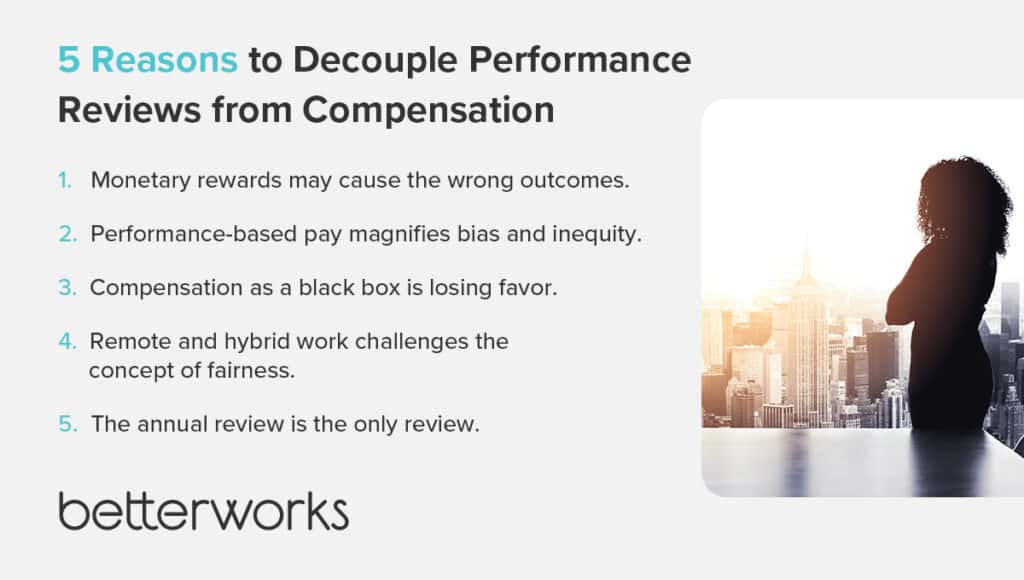
It’s time to reimagine a system that rewards employees fairly
The fundamental problem with performance-based pay is that it’s based on external motivation versus intrinsic motivation. Intrinsic motivation includes meaning and purpose, goal achievement, and career growth.
Today’s organizations must think about performance more holistically than they’ve done in the past. To do that, they need a better understanding of what motivates employees. Pay is important, but it’s not everything. Merit-based rarely incentivizes employees to work harder or be more engaged. People choose careers and companies for any number of reasons, and purposeful work and individual talents, for example, are intrinsic motivators.
Beyond pay, companies must also consider industry demands, the economy, and the needs of employees, such as remote or hybrid work options, mental and physical health support, vacation time, and stock options. While pay tops the list of motivators, employees rank career growth and advancement high on their list of what’s important. They also want an inclusive culture and supportive community so they can realize their career goals.
To inspire the best work (and best attitudes), companies need to decouple compensation from performance to meet the needs of today’s workforce. This may sound radical on the face of it, but it actually will yield better outcomes.
Separating compensation from performance improves performance
To inspire the best work (and best attitudes), companies need to decouple compensation from performance to meet the needs of today’s workforce. This may sound radical on the face of it, but it actually will yield better outcomes. These are key steps companies can take to untangle the two.
- Develop non-monetary incentives that are meaningful to employees.
- Think holistically about total rewards, including benefits, responsibilities, workloads, schedules, flexibility, and other types of recognition for a job done well. Reframe compensation as total rewards.
- Consider variable pay only when the positions are tied to clear outcomes that are completely measurable.
- Be clear in your communications to employees about compensation criteria, how it will be calculated, and the benefits for all of making this change.
- Build a culture of transparency around compensation. Employees should feel comfortable discussing with managers and colleagues how compensation is structured. Transparency will also bring pay inequities to light and help organizations close pay gaps.
Performance-based compensation puts all the focus on extrinsic motivation and doesn’t give employees anything to aspire to beyond rewards. Your organization will achieve far more by encouraging employees to see what they’re capable of and helping them achieve that through performance enablement. That’s why the decoupling of performance and compensation needs to be accompanied by a shift from performance management to performance enablement.
There are two reasons for this: First, traditional performance management fails when businesses are only giving employees annual reviews. This is for many of the reasons I outlined above, not the least of which is bias. Second, static performance management has given way to an agile, continuous, and integrated process that’s embedded into workflows.
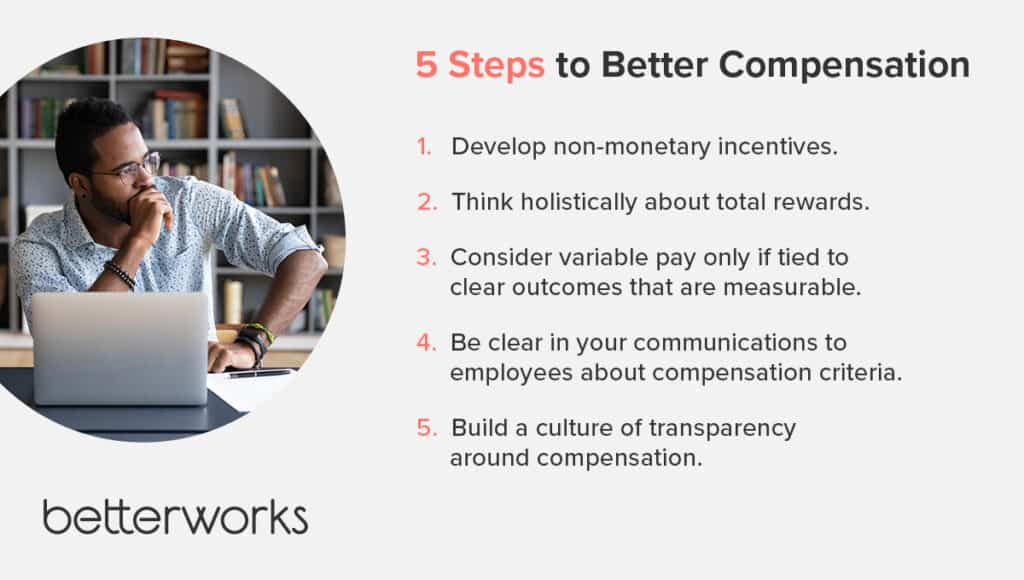

Mixing performance enablement and modern calibration
Performance enablement promotes intrinsic motivation and employee empowerment, giving employees a sense of autonomy, which drives greater engagement and job satisfaction. In turn, the company benefits from higher levels of employee performance. Importantly, performance enablement helps employees see what they’re capable of and helps them achieve it.
How does a company start its performance enablement journey? It’s a combination of people, processes, and technology. These are some best practices we cover in Make Work Better.
- Have quarterly performance reviews, but hold compensation conversations separately when it makes sense, not because it’s tied to an annual or semi-annual review period.
- Perform precise, unbiased calibrations throughout the year, driven by managers instead of HR.
- Use a performance enablement platform that facilitates the shift from traditional review practices to modern ones. Using Betterworks, calibrations aggregate rich performance data into clear, impartial insights about employee performance at a glance. With it, you can make timely and fair data-driven talent decisions anytime, not just during the year-end appraisal process.
- Throw out compensation ratings. Ratings can lead to bias. Concentrate instead on individual employee performance that you will have through the rich and recent data from your performance enablement process, and agree on a uniform way to allocate performance balances and pay.
- Use frequent calibration to improve performance and compensation. When you have adequate and easily accessible and transferrable data to drive calibration processes and when managers can help drive this process, calibration evolves from a painful once-a-year process to one that can be performed as needed throughout the year to make timely talent decisions.
If you have a junior engineer whose contributions and innovations you want to recognize and reward immediately through a job promotion and pay increase, you can do this at any time, and lessen the chance that you’ll lose your star performer to another company. Accelerated progression can also be a differentiator to help attract the best candidates for a role.
In Make Work Better, we cover each of the points in this section in far greater detail.
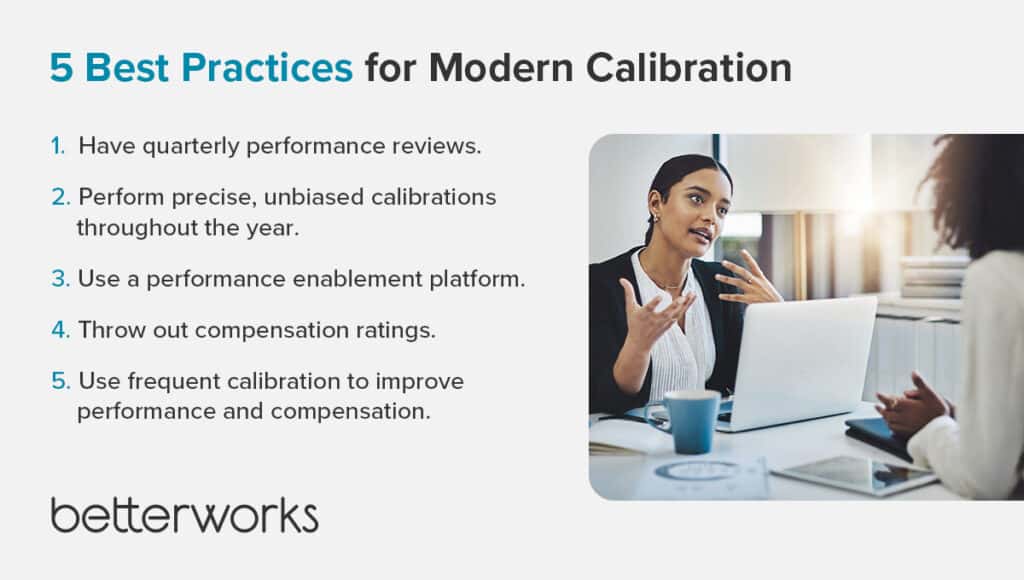
Case in Point: Optimizely
To attract and retain talent in its industry, Optimizely had to be able to compete for talent, especially in engineering, with much larger companies. The digital experience platform provider used Betterworks to establish real-time feedback and a quarterly review process to drive compensation and promotions.
The company ran calibration sessions after each quarterly review between managers and their reports, which led to better conversations about which talent to watch. To avoid creating the expectation of promotions every quarter and to make sure it remained competitive, Optimizely published the results of its compensation reviews. It posted the performance (objectives and key results, or OKRs) of every employee, including the CEO. Employees — and especially the engineers — better understood how the company was evaluating them and what to work toward.
One of the unexpected and positive downstream effects of this approach was a faster release cycle for technology enhancements, which went from once a year to once a quarter. The engineering team loved it because the company became more agile, while HR leveraged it as a recruiting tool to attract top talent.
Why make changes now?
So much is new in the post-pandemic world, accelerating the change that was already underway. Employees work differently and have new expectations of their employers and the role work plays in their lives. Meaning, autonomy, purpose, and culture matter now more than ever before, and as our 2023 State of Performance Enablement report shows, career development is once again high on the list of what matters to employees.
The pace of this evolution requires good and agile goal-setting. It requires a transformation from traditional, top-down goal management and one-way communication to continuous bilateral discussions between employees and their managers, along with frequent recognition and feedback from peers.
Looking at compensation in a new light is part of this reimagining of work, too. The best strategy looks beyond performance, ratings, and pay, and includes the multiple facets that make work valuable and meaningful to employees.
If you would like to learn more, we have a pre-recorded demo that you can watch, or you can request a personalized 1:1 demo from the same link.
Better compensation practices. Better performance.



